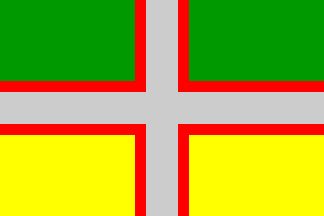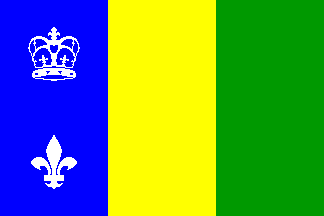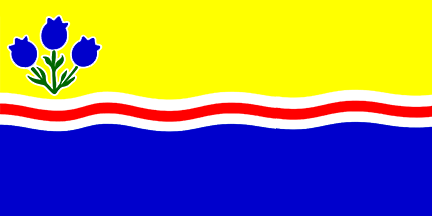 image
by Luc-Vartan Baronian
image
by Luc-Vartan Baronianproportions: 2:3

Last modified: 2017-05-11 by rob raeside
Keywords: quebec | canada | saguenay | anse-st-jean | cross: grey (fimbriated red) | crown | fleur-de-lis | blueberry |
Links: FOTW homepage |
search |
disclaimer and copyright |
write us |
mirrors
See also:
Outside Link:
 image
by Luc-Vartan Baronian
image
by Luc-Vartan Baronian
proportions: 2:3
The name "Royaume du Saguenay" is still the nickname of this area and though
it is now use in the administrative region of Saguenay/Lac-St-Jean, it does not
represent it in any official capacity and it was created at a time when
the saguenay was considered a separate region.
Marc Pasquin. 24 September 2004
Saguenay region is on both shores of the Saguenay river in Quebec. It's part of the Saguenay-Lac-St-Jean administrative region (is the flag used in Lac-St-Jean also? I don't know...).
The name "Kingdom of Saguenay" takes its origin in a legend from the beginning of the French colonisation in the sixteenth and seventeenth centuries. According to the Algonquian Indians, their was a Kingdom of white blond men rich of gold and furs in the north in a place they called Saguenay. French explorers looked for this kingdom in vain... Today, some people think it was an ancient Viking settlement that the Algonquian oral tradition referred to.
The proportions of the flags I've seen were always 2:3, and the cross including the red and grey parts is 1/6 of the length. This is exactly like the flag of Quebec. The 4 colors used represent the 4 elements of the richness of Saguenay : the green is for the forest and is placed on the top to show its ancient; the yellow is for the agriculture and is placed at the bottom like the ground that provides it ; the grey is for it's industry disposed as a cross to signify its exploitation and distribution role ; the red is for the population putting in highlight the other elements.
This flag was adopted in 1938 to commemorate the beginning of its colonisation
in 1838. It is still in use.
Luc-Vartan Baronian, 27 January 1997
Its gray cross represents the aluminum, which is an important part of our industry. The red border represents the labor of the inhabitants. The green color represents the forest and the yellow represents the agriculture. This flag was created in 1938, for the 100th anniversary of the arrival of the first settlers. Its creator was Mgr Victor Tremblay, a local historian.
There is also a regional day which is celebrated on June 11th and a regional anthem.
The region is divided geographically into two parts: the Saguenay, located
on the Saguenay river and the Lac-St-Jean, located on the Lake St-Jean.
Nelson Belley, 12 January 1998
When the first European discoverers (Jacques Cartier, and others) sailed up the Saint Lawrence river, they came upon a very important fjord-like river flowing into the Saint Lawrence, and called the Saguenay river (not a lake). It was immediately believed that it would be an important route of penetration into the continent.
The King of France decreed that the area drained by the Saguenay would remain his personal domain, and that new settlement would not be authorized. Thus the expression " Royaume du Saguenay " or Saguenay kingdom.
In practice, the wealth of the land was then furs, not gold and gemstones.
The French Crown (and later the Hudson's Bay Company) dealt in furs with the small resident Amerindian population. European settlement started only around 1845, with agriculture and forestry.
Today, the area supports a population of more than 200,000, with the main activities being forestry, newsprint manufacturing and aluminum smelting.
The region is a very proud and nationalistic one. Around 1950, a regional flag was created by a priest called Mgr Victor Tremblay, who was involved in the regional historical society. The flag design and colors are all symbolic of regional peculiarities :
Jean-François Bouchard, 2 May 1998
The comparison with the Spaniards' Eldorado is a good one, historically, but
the myth did not last very long. The name stuck, though. There is absolutely no
such thing as a Saguenean nationalism (nobody ever talked of a Saguenean nation),
and the people of the region identify themselves along the same lines as the rest
of the population of Québec. If the electorate of the region favors the option
of Québec's independence from Canada in a larger proportion than anywhere else
in the province (with the notable exception of the French-speaking Montrealers,
might I point out), it would still be unfair to them and totally inaccurate to
speak about ultranationalism in the Saguenay. And if there were a noticeable lake
that would be the "centre" of the Saguenay region, it would be the Lac St-Jean
(Never heard of a Lake Saguenay). In fact, the region is commonly referred to
as Saguenay-Lac-St-Jean, inhabited by "Saguenéens" and "Jeannois"; that last nuance
is lost to most Québécois from outside the region, the distinctive Saguenean accent
is but one variant of the French language.
Éric Mercier - 24 May 1999
The flag day is the 11th of June, which is also the day of Saguenay-Saint-Jean.
The flag is which are manufactured in 6" x 9", 24" x 36", 36" x 54" and 36"
x 72" sizes.
Ivan Sache, 19 June 2004
According to Radio Canada, 1 June 2004, the Liberal Party uses the flag of Saguenay on its campaign documents released in the region of Saguenay. The Liberals say they want to highlight the interest of their three local candidates for regional matters. Their rivals say it is a lame attempt to hide the dramatic decrease of the popularity of the party. The Liberal Party already used, successfully, the flag of Saguenay in former elections.
The rights of use of the flag belong to the Historical Society of Saguenay. The Liberal Party asked permission to use the flag, which was given, as it would have been given to any other party.
The full story, with pictures, can be read on:
http://radio-canada.ca/regions/saguenay-lac/nouvelles/200406/01/004-liberaux_drapeau.shtml
Ivan Sache, 2 June 2004
This is a description of the flag by its designer, Mgr Victor Tremblay:
Ivan Sache, 19 June 2004Un drapeau c’est un pays, avec ses gloires, ses beautés, ses grandeurs, son firmament, sa glébe et ses eaux.
Un drapeau c’est tout un peuple, le travail de ses hommes, le sourire de ses femmes, la candeur de ses enfants.
Un drapeau c’est une âme, l’âme d’un pays."A flag is a country, with its celebrities, its beauties, its glories, its firmament, its glebe and its waters.
A flag is the whole of a people, the work of its men, the smile of its women, the ingenuousness of its children.
A flag is a spirit, the spirit of a country."
 image
by Luc-Vartan Baronian, 7 August 1997
image
by Luc-Vartan Baronian, 7 August 1997
The blue and white are taken from the flag of Quebec, while the yellow and
green are the main colours of the flag of Saguenay-Lac-Saint-Jean. The blue is
for the oceans, the white for the wed, the yellow for the agriculture and the
green for the continents. The presentation reminds the French Tricolore, the crown
has a heart on it and is heart-shaped, because it's a monarchy based on love!
The fleur-de-lis is the one from the Quebec Fleur-de-lis.
Luc Baronian and Donald Gauthier, 7 August 1997
I heard on our national news last night of a new kingdom, L'Anse-St-Jean, located
in the Saguenay region of Quebec. The people (1400 of them) had a referendum to
appoint a king for themselves (he is King Denis, formerly Denis Tremblay), and
the referendum succeeded by 72%. He plans to have a crown made, hold a coronation,
and reign. His one biggest concern was he would no longer be able to go to the
bar with his friends.
Rob Raeside, 23 January 1997
As I have said before, there is a new Kingdom in the Saguenay region of Quebec : the Municipal Kingdom of Anse-Saint-Jean, a small village. See: http://www.roidelanse.qc.ca/
You can see the Royal Arms, the text of the Royal Anthem and an advertisement... of the Royal Beer!!
There is no flag on the site (at least, I didn't see one), but according to
Mr. Gauthier, their flag is Blue with a centered crown (a possible allusion to
the Legendary Kingdom of Saguenay), but they are looking for a new one.
PS : The site is in French only.
Luc Baronian, 21 April 1997
The Municipal Kingdom of L'Anse-Saint-Jean, presented as "the first monarchy
ever in America", was established following a referendum held on 21 January
1997, approved by 74% of the voters. The Municipal King, Denys I de
L'Anse-Saint-Jean, was crowned on 24 June 1997 by the parish priest, Raymond
Larouche, during a ceremony organized in the village church. The referendum was
compliant with the national and provincial legislation. The monarchy was
non-hereditary and the king could be deposed by referendum; he had no privileges
and the kingdom would not cost anything to the municipality.
The
establishment of the kingdom was seen as a means of boosting the local economy,
ruined by the "Saguenay deluge" that had devastated the village in 1996 and the
crisis experienced by winter tourism in Saguenay. The to-be king, Denys Tremblay
(b. 1950) was a noted artist and performer; he earned a Ph.D. on environmental
sculpture at the Paris-VIII University, performed for years as a character named
"L'Illustre Inconnu" (The Illustrious Unknown) and served as a professor at the
University of Quebec - Chicoutimi. Tremblay proposed to create a huge
"environmental fresco" depicting the face St. John the Baptist, the village's
patron saint, on the side of Mount Edward. Of 30 m in high, the "environmental
sculpture" required the total revamping of the forest. The project called
"Saint-Jean-du-Millénaire", was expected to be funded by the symbolic sale of
nobility titles and estates.
Originally welcomed with enthusiasm by most
of the local population, the Municipal Council, and the artistic community, the
project soon stirred up bitter controversy. Accused of megalomania - the saint's
face was, allegedly, modelled on the king's face - King Denys I eventually
abdicated after three years of reign, on 14 January 2000. He deposed his crown
in the presbytery of the village, witnessed by the parish priest, the mayor, and
two inhabitants of the village.
The full story of the kingdom was related
by the philosopher Hervé Fischer in the book "Un roi américain" (2009). A friend
of the king, Fischer considered the establishment of the kingdom as "a main
event in the history of arts", systematically denigrated by the local "trash
radio channel" and powerful families.
https://princefou.com/2015/10/18/le-royaume-de-lanse-saint-jean-la-premiere-monarchie-en-amerique/
- Guy Boulianne's blog, 18 OCtober 2015 - with archive news footage and a photo
of the flag
http://www.ledevoir.com/culture/livres/259496/un-roi-comme-sujet - Le
Devoir, 18 July 2009
Ivan Sache, 1 April 2017
 image
by Marc Pasquin, 31 October 2016
image
by Marc Pasquin, 31 October 2016
This flag is cited in The Saguenay Flag [hrg88a] as being the flag of the Lac-Saint-Jean part of the region. I am not sure exactly if it was a proposal or a short-lived flag, but currently the green-yellow flag with the grey-red cross is widely used in the region. The bottom blue part represents the lake, the triple blueberry stem is a reference to this popular berry in the region and to the popular nickname of the Lac-Saint-Jean residents: "Les Bleuets" 'the Blueberries'. Lac-Saint-Jean is considered to be formed of the three following counties: Lac-Saint-Jean-Est, Le Domaine-du-Roy and Maria-Chapdelaine.
Reference: Harrington, Kevin. 1988. The Saguenay Flag [hrg88a]
in Flagscan [fsc] no 11, Fall 1988.
Luc Baronian, 5 May 2005
This Flag has been suggested and adopted, but as the Saguenay flag is so
popular, most of the residents of Lac St Jean don't even know that we
have another one.
Manon Hamel, 17 August 2007
While not having the same level of recognizably as it Saguenay
cousin, the flag of Lac-Saint-Jean appears to be gaining in popularity. A Facebook page
dedicated to its promotion can be seen here:
https://www.facebook.com/drapeauLacStJean
The flag is also mentioned on
the site of the tourism agency of Alma (click "les drapeaux de la region"):
http://tourismealma.com/fr/destination/culture-industrie-et-patrimoine/
This, combined with the fact that it can be seen in the following picture
taken in the office of the mayor of the town of Alma would make one assume that
it is now achieve a least some level of recognition:
http://ville.alma.qc.ca/wp-content/uploads/2014/10/Pompier-et-pompi%C3%A8re-dun-jour-2014.jpg
Note that the blue on the image on the tourism board page appears much less
saturated then those I found online. As this appears common to converted SVG
images, I went with the more common medium blue. It should also be noted that in
the absence of official regulation, many variants in term of design and shades
are bound to appear anyway.
The flag was designed and adopted in 1971 by
Jean-Marie Fortin of Roberval. Its symbolism was explained as:
the
blueberries: "bleuet" is the nickname of the inhabitants of the Lac-Saint-Jean
yellow: agriculture
white: industry
blue: Pekuakami (the name of Lac-Saint-Jean
in the local Ilnu language)
red: the great fire of 1870
the
wavy lines: the lake itself
Marc Pasquin, 31 October 2016